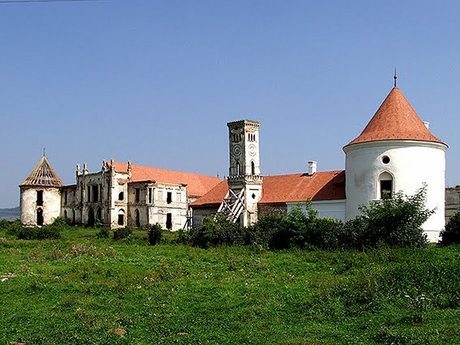Banffy Castle
Bánffy Castle (or Bonţida Bánffy Castle) is an architectonic Baroque monument situated in Bonţida (Bonchida / Bruck), a village in the vicinity of Cluj-Napoca, Romania. It was owned by the Bánffy family, and sometimes also called "The Versailles of Transylvania". The today owner is Katalin Bánffy.
Bonţida was a significant place from the 12th century as a royal possession, belonged to the neighboring counties' royal salt mines. It became inhabited again in the 13th century, after the Mongols' invasion. The history of Bonţida links with the Bánffy family from the end of the 14th century, when King Zsigmond donated Bonţida with the localities belonging to it, to the son of Tamás named Dénes in 1387. After on, the Bánffy family possess Bonţida over centuries.
The once single nave church was built in the 12th century with a semi-circular sanctuary, which was demolished in the second part of the 13th century, when enlarged, the church got the new nave and the straight ending sanctuary. The walled up southern gate and the two semicircular windows belonged originally to the first, 12th century church.
According to a military report, a fortification system already existed, that surrounded the manor house. It is suspected that on this spot a nobiliary residence existed since 14th century, when Baron Bánffy received from King Albert the permission to build a fortress. The construction of the castle started possibly after the Budai Nagy Antal revolt in 1437 by Bánffy Miklós and was finished in 1543. The construction of today’s castle was initiated by Denes Bánffy and lasted between 1638-1674, having as architect the Italian Agostino Serena. His heir, Denes Bánffy II reconstructed the castle beginning with 1745 in baroque style, following the plans of the Viennese architect Joseph Emmanuel Fischer von Erlach. The reconstruction was concentrated on the honor courtyard from the front of the gate building, and was inspired from the Viennese baroque architecture. New buildings have been constructed, such as: the stables and the homes of the servants. He was also the one who gave the castle its new shape, that of two wings in the shape of the letter U. A new wing was built in 1850 by the architect A. Kagerbauer, while Johann Nachtigall sculpted the “Metamorphosis” of Ovidius through imposing stone statues which decorated the gate. Jozsef Bánffy decided the demolition of the gate tower in 1820, uniting the renaissance courtyard with the baroque one, and from the remaining stone the close by water mill was constructed. He also decided the transformation of the baroque park into an English romantic one.
In 1944 the castle was evacuated of its owners by the German troups in order to use it as a military hospital. The building was seriously damaged at the end of the WWII, when the German troups that were retreating, attacked, robed and burned the entire ensemble. The entire furniture, the well known portrait gallery and the library were destroyed. The castle was neglected by the communist regime in Romania. The Art Museum from Cluj-Napoca was able to save the statues from the baroque park, keeping them under storage in the donation section, where they are to be found today. In the 60’s the Historic Monuments Direction tried to restore the castle, but the lack of funding could not lead to any concrete action. The castle was still used for the storage of construction materials, the park became a pasture zone and the trees have been cut down as fire wood.
The castle is currently being restored by the Transylvania Trust, with funds from the European Union, Romanian Ministry of Culture, Getty Grant Programme, World Monuments Fund, NKA (Hungary), etc. The Castle of Bonţida is now being restored as a cultural center. An apartment is being prepared for the use of the Count's family. The Built Heritage Conservation Training Centre, opened on the 26th of August 2005, received the main prize for education and awareness raising by the European Union/Europa Nostra in 2008.
The historic environment offers a perfect setting for the enjoyment of cultural activities.
The BHCT Centre promotes the full use of the historic environment within its educational and cultural programmes as a means of familiarising the public with, and helping them to understand and enjoy the quality of historic buildings and landscapes. Bánffy castle is one of the most spectacular ensembles in Transylvania and is therefore a perfect venue for cultural activities.
Through the Bontida Cultural Days the castle offers a full weekend of events and cultural activities which has proved increasingly popular to a wider public since its inception in 2002. The events are designed to be inclusive of all ethnic groups ( Bontida is the home of Romanian, Hungarian and Roma people, in equal proportion). Consequently events incorporate music and dance from each of these origins, together with additional concerts, theatre and special events for children. The Cultural Days also offer the opportunity to promote the work of local craft businesses, other project initiatives (such as the British Council’s Magic Pencils initiative for children), as well as involving the public in the workshop skills which are being taught at the castle. The Incitato Riding School is a popular attraction each year.
Each year attracts more and more people. In 2004 the event attracted 1500 people. Their enjoyment, clear from the illustrations, marks a major change in the way the historic environment is perceived in Romania.




